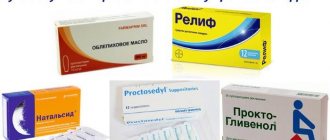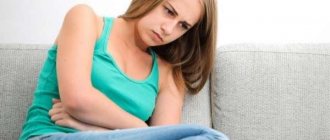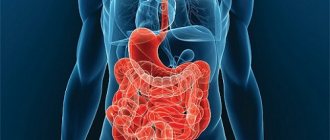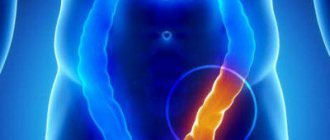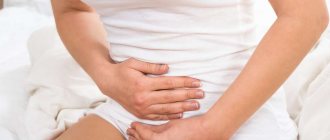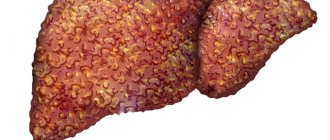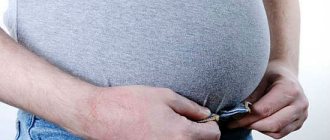Causes
Women are more likely to experience pain in the lower abdomen and lower back than men. People often use analgesics to relieve such symptoms. Why does it hurt? Pain syndrome localized in the lower abdominal zone in the lumbar segment is caused by acute and chronic pathological processes. In the acute stage (hemorrhage, organ rupture), the pain is very strong and sharp.
If the inflammatory process occurs chronically, then the pain is dull, aching in nature, and occurs constantly. With throbbing pain, the pressure inside the cavities is increased. An accurate diagnosis is made in a hospital setting after diagnostic procedures have been performed.
If the intestines are inflamed
If pain appears in the back and abdomen at the same time, then the causes of the pain are dysfunction of the intestinal tract. Pain in the lower back and lower abdomen, which radiates to the groin area, may be the result of inflammation of the intestinal tract. If you ignore such pain, ulcerative processes will occur in the intestines.
If such pain was aching in nature and radiated to different parts of the body, and then became cramping, then the patient requires urgent medical attention. In addition to pain, the patient will suffer from flatulence and hyperthermia. The acute stage of colitis can last 2 days. Without therapy, it will become chronic; there is always a pain in the stomach, but the pain does not manifest itself acutely.
Inflammation of the appendix
With appendicitis, severe pain in the abdomen radiates to the lower back, hyperthermia will also occur, the patient will feel sick and vomit. If you ignore such pain on the lower right, the appendix will rupture and a septic condition of the abdominal cavity will occur. The pain can also be dull and aching. Without treatment, the patient will die.
Other causes of pain:
- With an inguinal hernia. The patient has severe pain in the abdomen and back, the pain syndrome is similar to appendicitis. A person may lose consciousness from such pain. Urgent surgery is required.
- Renal pathology. If the lumbar area ache, sometimes urination is impaired, hyperthermia appears, pain occurs on the left or right side of the lower abdomen, then this is how pyelonephritis and other pathologies of the urinary system manifest themselves. The pain syndrome will always radiate to the groin area.
- Infectious processes. First, a nagging pain appears in the lower abdomen and lower back, later the pain will worsen. The stool contains mucus and blood. With salmonella infection, sepsis is possible, which will occur within a few days. If treated in a timely manner, complications will not arise.
- The prostate is inflamed. With prostatitis, the lower abdomen and lower back are pulled. Urination and defecation will also be painful.
- I suffer from osteochondrosis. The lower back hurts and the lower abdomen pulls, also with osteochondrosis. Dystrophic and degenerative processes in the spine will lead to the fact that the nerve roots are pinched and the internal organs will be poorly innervated. Therefore, the patient feels pain in the lower back, pain radiates to the groin and lower extremities.
- Oncology. If your stomach and back hurt at the same time, then there is a possibility of malignant neoplasms developing in the body.
How to help with lower back and abdominal pain
If you feel unwell due to abdominal pain, you should call an ambulance. Before the doctor arrives on call:
- take a comfortable horizontal position,
- don't eat anything, but drink more water,
- put the cold on the localization site.
Do not heat your stomach while taking a hot bath. You can aggravate the situation if we are talking about appendicitis, ectopic pregnancy, renal colic. Do not take pills or medications if you do not yet know the diagnosis.
Pain in women
Pain in the lower abdomen and lower back in women can occur due to menstruation, with premenstrual syndrome. Heaviness in the abdomen appears due to the fact that contractions occur intensely. This condition manifests itself in a woman when her hormonal levels are unstable. If a woman has given birth, then the presence of such a symptomatic reaction indicates serious pathologies:
- Inflammation of the uterus, fallopian tubes, vagina and ovaries.
- Oncological processes and tumors can be benign or malignant.
- An ovary ruptured. Blood can enter the abdominal cavity, causing sepsis.
- The leg of the cyst has twisted.
- Condition after abortion. The fertilized egg has not been completely removed, and there is a risk of septic infection.
When menstruation begins, the uterus enlarges and actively contracts, getting rid of blood clots.
If your stomach aches during pregnancy, then there is a possibility that labor will begin prematurely and a miscarriage will occur. Pain in the groin area will be more intense than in the lumbar area. If, in addition to pain, hemorrhage is observed, then hospitalization is required.
This condition can occur due to physical work, infectious processes, injury, and intrauterine pathological changes. Pregnant women may experience abdominal pain due to pregnancy occurring outside the uterus. A nagging pain will occur in the area where the fertilized egg is attached. The woman will suffer from flatulence, aching pain in the abdomen and lower back.
Painful periods
Pain during menstruation is considered normal if it lasts no more than three days and is not particularly intense. The phenomenon is often associated with a lack of prostaglandins, neurotransmitters that block pain signals during uterine contractions. Women cope quite easily with temporary troubles with the help of antispasmodic drugs and proper rest. The reason for contacting a gynecologist should be severe pain in the lower abdomen and lumbar region that accompanies each menstruation.
When a woman is bothered by pain in the lower abdomen, the causes of this condition can be very diverse. The pain felt in the lower back is associated with changes throughout the body. This is a kind of screen where diseases are projected. Often, pain in the lower back and abdomen in women occurs due to gynecological problems. But any organs located in the abdominal cavity can cause discomfort.
Appendicitis
If a woman has pain in the right side of her lower abdomen, or there is a pulling sensation in this area, it is important to react quickly. Perhaps these are symptoms of appendicitis. In this case, the initial symptoms are not clearly expressed; a dull pain may spread to the navel area or be felt in the upper abdomen. After a few hours, severe and sharp pains are observed that move to the lower abdomen, mainly to the right side.
Although the location of the pain depends on the location of the appendix, pain can be felt from the right hypochondrium to the pubis. Often the body temperature rises sharply. Nausea and vomiting occur, especially at the beginning of the attack. Active movements - coughing, sneezing, laughing - cause sharp pain. The tongue of some patients is covered with a white coating.
It would be superfluous to explain that this condition is very dangerous and under no circumstances should you wait it out. Ignoring pain can lead to a ruptured appendix. If the appendix of the cecum bursts, infection will instantly affect all organs of the abdominal cavity and sepsis will develop. This is a serious condition that very often leads to death.
Expert opinion
Filimoshin Oleg Alexandrovich
The treatment method is always surgical. Surgery is prescribed not only when the diagnosis is 100% proven, but also in cases of suspected acute appendicitis, when it is not possible to exclude acute inflammation of the appendix.
Intestines
Intestinal problems can also cause pain in the lower abdomen. There are many symptoms of intestinal pathologies, we list the most basic of them:
- Pain in the abdominal area, aching or in the form of cramps.
- The pain radiates to the lower back and chest.
- Nausea, vomiting, flatulence, and bloating are often observed.
- The stool is disrupted - diarrhea or constipation appears.
Such manifestations indicate the development of inflammation in the intestines. A bursting sensation indicates gas formation and difficulty moving intestinal contents. The causes of mucosal inflammation are varied. These are infectious diseases, poisoning, unhealthy diet, chronic diseases, etc. In the absence of timely treatment, there is a risk of developing peptic ulcer of the rectum or duodenum.
If the pain intensifies, or spasmodic, cramping pain appears, you must call an ambulance. The condition is life-threatening. A gastroenterologist treats the intestines; the drugs prescribed depend on the specific disease. For infectious diseases, the first stage of therapy is aimed at restoring fluid balance.
If it is a rotavirus infection, then before intestinal manifestations the patient is usually bothered by cold symptoms. Treatment occurs by replenishing fluid losses and using medications containing enzymes: Mezim, Pancreatin, Festal.
If you find a helminthic infestation, then this disease will be eliminated by anti-worming drugs. There are many of them, but their purpose depends on the specific type of parasite. While taking medications, you must follow a diet: exclude dairy products, chocolate and desserts with creams.
Gastrointestinal dysfunction occurs from poor nutrition. It often occurs after feasts. Treatment consists of following a diet and drinking plenty of fluids - at least 2 liters of fluid per day. Green tea, mineral water, juices are perfect, but not in the acute stage. The diet must be followed during any treatment. Smoked, fried and too fatty foods are strictly prohibited.
Our life expectancy directly depends on the condition of our kidneys. These organs are responsible for the circulation of all fluids in the body. If you have kidney problems, the pain radiates to the lower back. Initially, kidney dysfunction appears due to poor lifestyle: nutrition, hypothermia, genitourinary tract infections and genetic predisposition.
Your kidneys will be much healthier if you lead a healthy lifestyle. Long walks and physical activity are required. Consume as little salt as possible and, of course, fatty, fried and smoked foods. The kidneys are also affected by the state of the nervous system. They react to nervousness. For these organs to function normally, you need to get enough sleep.
When your lower back and lower abdomen hurt, the question arises: what could it be? Unpleasant sensations are caused not only by the internal organs of the abdominal cavity. Pain due to osteochondrosis, which causes problems with spinal tissues and intervertebral discs, can radiate not only to the back. This disease has symptoms that mimic other diseases, sometimes making diagnosis difficult.
Older people are more susceptible to the disease. Frequent manifestations of the disease are lower back pain, nagging, weak and severe pain in the spine. Sometimes the pain is very strong - in the form of lumbago. A person gets tired quickly and may notice a loss of sensation in the limbs (numbness), pain radiating to different parts of the body, and he often has a headache.
In case of acute manifestations of the disease, the patient is prescribed bed rest. The neurologist prescribes analgesics, which are taken hourly: Paracetamol, Sedalgin, Analgin.
Inflammation of the colon is manifested by abdominal pain, which very often affects the stomach. The chronic course of the disease is almost asymptomatic. The affected mucosa requires long-term treatment. Pain in the left side of the abdomen, radiating to the lower part, is accompanied by disturbance of stool. After defecation it becomes easier. Bloating and a feeling of heaviness are also present.
Before prescribing treatment, studies are carried out to identify the pathogen. The main thing in the treatment of colitis is diet. All products that irritate the gastrointestinal tract are excluded, preference is given to cereals and fermented milk products. In addition, symptomatic therapy is carried out.
Infection
The proliferation of pathogenic microbes in the intestines causes serious discomfort. The pathogens are different, but the symptoms are usually similar. Depending on the characteristics of the patient’s body and the stage of development of the disease, the following symptoms may be observed: loss of appetite, nausea, pain in the lower back and abdomen. The stool is disturbed - most often the patient is bothered by diarrhea. Blood clots or mucus are found in the stool. In case of infectious diseases, you should consult an infectious disease specialist.
During treatment, it is imperative to follow a gentle diet. Gastric lavage is a procedure used for food poisoning. The body's water-salt balance plays an important role. Therefore, you need to constantly take special solutions (Rehydron, Glucosolan, etc.) and drink a lot of water. Indomethacin is used to normalize stool. Be sure to prescribe sorbents and means to improve intestinal flora.
When is help needed?
Why does the lower back hurt during pregnancy?
Medical assistance is necessary in the following cases:
- if the pain does not stop within 60 minutes;
- it increases with coughing and movement;
- before the pain, bowel movements do not occur for a day, the patient suffers from flatulence;
- stool contains blood clots. If it is black in color, then internal hemorrhage develops.
What is prohibited?
Self-medication is not recommended. If the patient drinks an analgesic, the symptoms of the pathological process will change. The disease can worsen because the symptom is temporarily eliminated, so the patient does not seek the help of a doctor. You should not drink liquid. It is permissible to wet the tongue and lips, but the liquid must not enter the stomach. Warm compresses are not applied, since bacterial microorganisms will multiply faster in a warm environment.
You should not use an enema or take laxatives, as dehydration will begin.
Intestinal diseases
The cause of discomfort in the pelvic area is intestinal disease.
They cause the following set of symptoms:
- the patient has a stomach ache;
- discomfort radiates to the lower back, groin and chest area;
- increases gas formation in the intestines, which is why a woman feels like her stomach is “bursting” from the inside;
- nausea, vomiting, loss of appetite occurs;
- stool is disturbed.
If a patient has intestinal pain, the doctor may suspect the following problems: infection, poisoning, intestinal obstruction, ulcerative colitis, perforation of the small intestine, etc. To eliminate unpleasant sensations, you must definitely consult a doctor: delay or the use of traditional methods leads to a worsening of the situation and progression of the disease.
Pain of various types in the lower abdomen, moving to the lower back, may be a sign of intestinal dysfunction (disorder):
- If the painful sensations are accompanied by diarrhea or constipation, then the problem is most likely a violation of peristalsis. When mucus or blood appears in the stool, inflammation of the intestinal mucosa is usually diagnosed - colitis. In both cases, you should consult a doctor and undergo a course of appropriate therapy without self-medicating.
- Pain in the abdomen on the right and back, accompanied by a sharp increase in temperature and nausea, is extremely dangerous. The most likely cause of these symptoms is inflammation of the appendix, which must be urgently removed. Without surgery, the appendix ruptures and peritonitis begins, often ending in death from sepsis.
Benign and malignant tumors can also develop in the intestines, so if you experience characteristic pain, you should see a doctor immediately. Doctors recommend annual preventive examinations for timely detection of tumors.
Diseases and injuries of the lumbar spine are one of the possible causes of constant pain in the back and lower abdomen. Mechanical damage to the vertebrae is often accompanied by their displacement and, accordingly, pinching of the spinal nerves. Depending on the location of the injury, pain can spread not only to the back, but also to the pelvic organs. As a preventive measure, ladies should avoid traumatic situations and not lift heavy loads.
Age-related changes in women are very often accompanied by the development of osteochondrosis. With this disease, the cartilage and bone tissue of the spine is deformed, which leads to pinching and inflammation of the nerves. When the lumbar region is affected, the pain spreads to the abdomen. Osteochondrosis can be prevented by physical activity and proper nutrition (a woman’s diet should be rich in foods containing collagen and calcium).
Diagnostics
For pain in the abdomen and lower back, the doctor will prescribe diagnostic procedures:
- Magnetic resonance imaging. It will help identify the causes of pain.
- General examination of blood and urine to detect inflammation in the body.
- Ultrasound examination. It will allow you to study in detail the organs located in the pelvis.
- Tests for pathologies that are transmitted through sexual contact. Sometimes such pain occurs with these diseases.
Any pain is a signal that there is a malfunction in the body. It is important to understand that ignoring pain will lead to complicated conditions and a threat to the patient’s life. Only medical diagnosis can accurately determine the cause of pathological processes in the body. Therefore, if pain occurs, you should seek help from specialists as soon as possible.
Diseases of the genitourinary area
The pelvis contains the female reproductive and urinary organs. Pathological changes and inflammatory processes in them always result in pain in the lumbar spine and lower abdomen. For a more accurate diagnosis, you should find out the nature of the sensations (pulling, cutting, sharp or dull pain), as well as the intensity and frequency of the phenomenon.
Constant pain in the lower abdomen moving to the lower back, intensifying during menstruation, may indicate chronic inflammation of the uterus and its appendages. The causes of the pathology are usually sexually transmitted infections and hypothermia. Contacting a specialist and the treatment prescribed by him cannot be delayed, since chronic inflammatory processes often result in infertility. For prevention, it is enough to streamline your intimate life and dress according to the season.
Neoplasms in the uterus and ovaries are another possible cause of pain. Polyps, cysts, fibroids and malignant tumors grow and interfere with the normal functioning of the organ. Characteristic symptoms of such diseases, in addition to pain in the lower abdomen and lower back, are menstrual irregularities, frequent bleeding and infertility. Neoplasms are most often treated surgically, and regular preventive examinations will help prevent their development.
Pain that occurs during sexual intercourse and continues for some time after it may be a sign of the following pathologies:
- abnormal structure of the internal genital organs (bending or prolapse of the uterus), which contributes to their mechanical damage during intercourse;
- erosions or polyps of the cervix;
- damage to the vaginal mucosa by bacteria and fungi.
Regular visits to the gynecologist and timely treatment will help to successfully get rid of such problems.
Located next to the reproductive system, the excretory system is subject to the same negative influences. Hypothermia and infectious agents cause inflammation of the kidneys, ureters and bladder. In addition to pain of varying intensity in the lower back and abdomen, the most characteristic sign of the disease is hematuria - blood in the urine. Acute inflammatory processes in the organs of the excretory system are accompanied by a sharp increase in body temperature.
The growth of tumors in the kidneys or bladder is also accompanied by pain in the back and abdomen. Unlike inflammation in the acute phase, with neoplasms pain increases gradually. You should see a doctor if you have any dysfunction of the excretory organs or discomfort, since early treatment has a positive effect on the success of treatment.
